What the e-scooter industry hasn't figured out about Santa Monica: It's recreation not transportation
Every attempt isn't necessarily a success. I have a post about bike sharing from 2016, "The problem when you define every outcome as a success, you don't learn, and therefore failure is more likely: bike share in Seattle and Los Angeles as examples," lamenting the positivism in bike planning, and that when you term everything a success, you don't learn very much, and it becomes almost impossible to improve.
Also see the follow up post from 2017, "Quote of the day, revisiting 'when you define everything as a success'."
Then I mentioned how other cities, like Seattle (and their bike sharing system failed) used DC as an example of why they would be successful, not acknowledging that most of the revenues generated by the system outside of memberships came from tourists who either didn't care or didn't understand that they needed to use the bikes in less than 30 minute increments to not rack up additional fees.
Dockless scooter and bike sharing ignored the most important lesson from the initial experiment with bike sharing: People wreck and steal unsecured bikes. Interestingly, it's amazing that the dockless bike and scooter sharing industry ignored the initial lessons from the first creation of bike sharing in Amsterdam in 1965 ("Story of cities #30: how this Amsterdam inventor gave bike-sharing to the world," Guardian). If you don't provide a method for securing the bikes, most will be wrecked by vandalism or stolen.
That's why modern bike sharing systems use docks and very hardy bikes, to withstand public use and ward off vandalism.
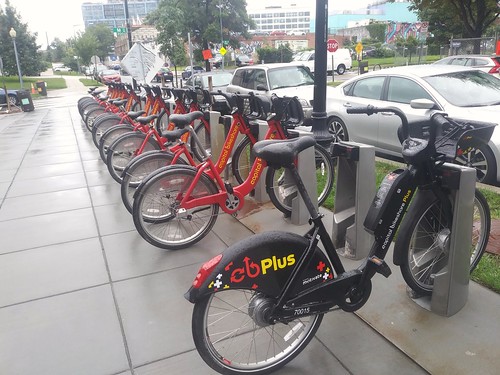
Capital Bikeshare dock.
Santa Monica as the home to the e-scooter (stand up scooter) "revolution." I finally got a chance to check out Santa Monica--the pier, the Third Street Promenade pedestrian mall, and such, observing a lot of use of bikes and scooters and skateboards and other sustainable mobility modes.

The city is where the modern e-scooter business started, when Bird dropped thousands of scooters on the streets ("Dockless scooters as an example of a lot of money sloshing around in venture capital," March 2018).
The city feels inundated given their creation of billboards explaining how people should use them. They've also created painted e-scooter parking boxes to try to prevent people from discarding them in uncivil ways on sidewalks and other places.
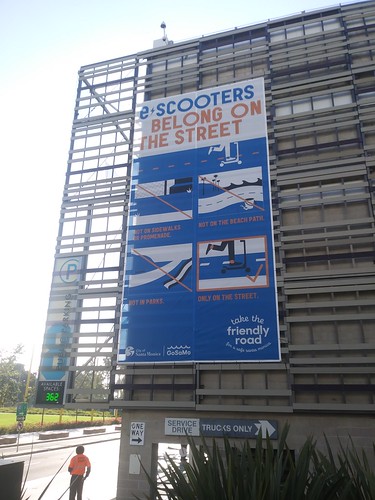
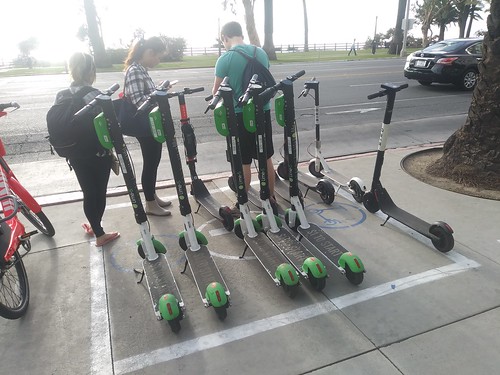
Beach communities are hotspots for recreational biking. Most beach towns have a high level of biking, as an element of the outdoor culture of the community. This is true in Virginia Beach, Cape Cod, in various communities in Florida, in Huntington Beach and Newport Beach in Orange County, beach communities in San Diego County, etc.
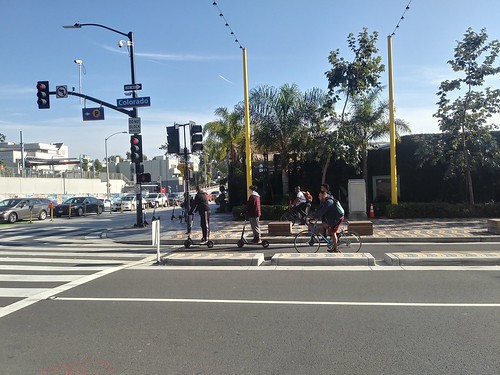
icyclists and scooter riders in Santa Monica on Colorado Avenue
Bike rental is a huge part of the tourist experience and is a major element of beach-related business ("Most Bikeable Coastal Cities in AmericaBest Boardwalks for Cycling," Bicycling Magazine; "8 Great Florida Beach Towns for Bicycling," HuffPost Life; "Bike-Friendly Coastal Towns In The Northeast," MetaEfficient).
In Santa Monica, this is evidenced by Bike Center Santa Monica, a bike shop that rents bikes and supports commuting (in a separate operation with secure bike parking, showers, and lockers, independent from government support other than likely cheap rent in a city parking structure), with a shop with roll up doors, located in a prominent location in a city parking structure, one block from the Downtown Santa Monica Metro Station and the Third Street Promenade pedestrian mall.
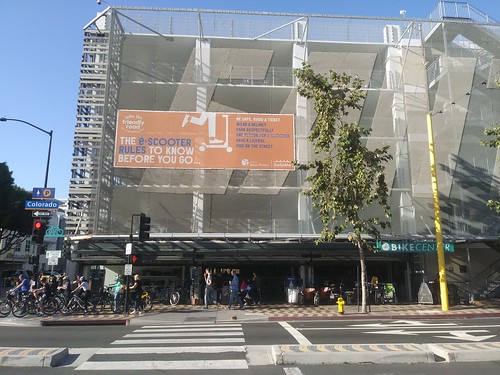
I've never seen a bike shop mobbed quite like that one. It was impossible to interview any staff because they were so busy (although earlier in the day I talked to a person at the Bike Hub at Union Station, which is run by the same firm).

Photo: Bike Center Santa Monica.
Recreational bike and scooter use rarely translates into transportational use. But they are not using e-scooters or renting bikes at Bike Center for traditional transportation use, specifically for what is some times called utilitarian transportation, they are riding for fun, recreationally.
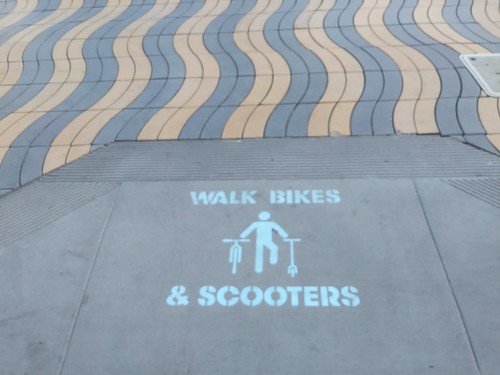
Talking 'bout revolution. And despite all the articles about how e-scooters are revolutionary ("The Year Of The Scooter: The Good, The Bad, And The Road Ahead," Forbes Magazine), frankly, I haven't seen it in practice, based on observation in DC, even though the city is a leader in mobility as a service and the creation of a multi-layered sustainable mobility platform ("DC is a market leader in mobility as a service (MaaS)") highly supportive of getting around without a car.
From the Forbes article:
As it turns out, companies like Bird, Lime, and JUMP had other ideas about how the future of transportation would evolve. It is clear that 2018 was in fact, the year of the scooter, and more broadly the year of the meteoric rise of micromobility. Bird and Lime are each estimated to be worth more than $2 billion (the fastest rise of any technology company ever before, including Uber). And the two U.S. ridehailing giants have both entered the micromobility race with their acquisitions of JUMP (by Uber for a reported $200M), and Motivate (by Lyft for a reported $250M).I do like the term micromobility.
-- THE MICRO-MOBILITY REVOLUTION: THE INTRODUCTION AND ADOPTION OF ELECTRIC SCOOTERS IN THE UNITED STATES, Populous
Sure, you see people in DC riding e-scooters (stand up scooters), but not swarms.
In Santa Monica, there are--if not swarms--multiple large groups of users and a highly visible number of individual scooter riders in the Downtown, on Ocean Avenue alongside the beach, on Colorado Avenue which is a main walking street to the Pier from the train station, etc.
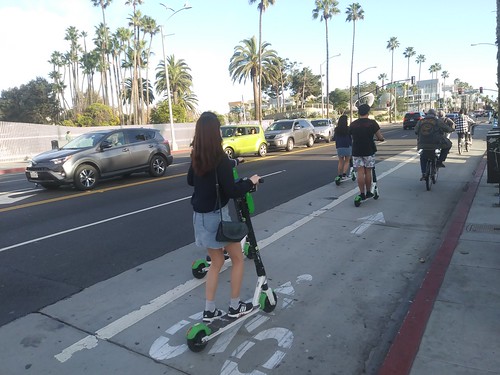
Generalizing from recreational to transportational use is a losing game. For a long time, I've argued that you can't really generalize from the use of bikes in beach towns to planning for transportation--except as a tourist transportation demand management strategy. Even when people will bike on vacation they tend to not adopt the attitude that biking is an appropriate mode for transportation "back home."
Biking on vacation is seen as something fun, bikes are toys to use while vacationing, not as a practical form of transportation.
It's pretty much the same for e-scooters, especially when you look at the experience of deployment in cities around the country.
The firms drop a lot of the scooters out on city streets. They experience high rates of breakage, damage and vandalism. For example, in Kansas City, in Lime's deployment, about one-third of the scooters were unusable after two weeks ("Lime scooters will leave KC temporarily, return this spring," Kansas City Star).
(Suzanne attributes this to the perception that the scooters are for recreation, and they treat scooters the way people treated their bikes when they were kids.) And you don't see with your own eyes a whole lot of regular and transportation usage.
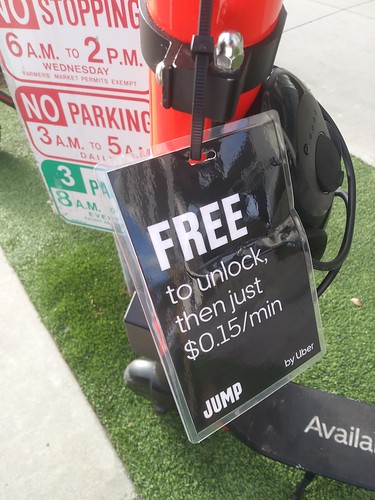 That's borne out by the data that's released. I can't remember what article I read, but it quoted a firm as listing the total number of users and trips as very high, but that the average total number of rides by a user was five. FIVE!
That's borne out by the data that's released. I can't remember what article I read, but it quoted a firm as listing the total number of users and trips as very high, but that the average total number of rides by a user was five. FIVE!If we're talking about serious transportational use, there should be at least 10 rides per week per rider (ideally at least 4 per day and at least 20 per week). Not five rides TOTAL per user..
Yes, more must be done to make cities supportive of sustainable mobility. The Forbes article raises some decent points:
... Will these companies revolutionize transportation in cities for the better? Will they bring us mass electrification of (smaller) vehicle fleets and more sustainable ways of moving around in cities? They can if we let them, but it’s going to take a lot more work and coordination with the public sector to get there.
The Good: Better Data and a New Coalition for Pedestrian and Bike-Friendly Streets. There are two important conversations that the arrival of electric scooters has forced upon cities: 1) regulation and active management of mobility services; and related to this: 2) redesigning urban space to make it easier to get around without a car.Yes, cities need to make sustainable mobility a priority (see "Further updates to the sustainable mobility framework"). But e-scooters aren't likely to be a major driving force.
Or at least, not likely to be the source of a large number of regular users of sustainable modes, despite the "first mile/last mile" problem--or the issue of getting to and from transit stations from your origin/final destination points.
Would dock-based scooters be treated and used differently? The big question is would scooters work better as a transportation mode if they were dock-based or had much more serious locking requirements.
The problem with dock systems is that they reduce availability--docks are expensive, and in bike sharing systems with high penetration, the closest dock is supposed to be no farther than 1/4 mile. The beauty of dockless bikes and scooters is that you can leave them right in front of your house or final destination, rather than have to go to or from a dock from your origin or destination point.
Still, that's the type of test that is needed to determine whether or not stand up e-scooters have a serious future as a mode and device for serious transportational use.
Direct assistance and support is necessary for people to shift to sustainable modes. Note that I think that the e-scooter livability stores that Lyft aims to pioneer ("LimeBike and "scooter lifestyle stores" as an example of forward marketing for sustainable mobility") will help.
Theoretically, so could jammed bike stores like Bike Center Santa Monica. They do have a commuter assistance/bike loan program to help people try out biking--just as many communities do in the UK ("Eight "mutual assistance programs" that can build support for biking as transportation on the part of low income communities").
The failure to provide systematic direct assistance in helping people transition to sustainable mobility is the biggest miss in transportation demand management and bike planning in the US.
While the "eight mutual assistance" entry focuses on building bike utilization take up on the part of low income communities, the points are relevant to all demographics of potential users of bikes for transportation.
Labels: bicycle and pedestrian planning, e-scooters, micromobility, sustainable mobility platform, transportation planning, urban design/placemaking



0 Comments:
Post a Comment
<< Home